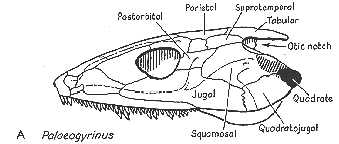THE OTIC NOTCH/ QUADRATE
BONE/ FOSSAE
AND THERE RELATIONSHIPS:![]()
THE OTIC NOTCH/ QUADRATE
BONE/ FOSSAE
AND THERE RELATIONSHIPS:![]()
Palaeontologists are like detectives of the ancient world. Attempting to see into the past by using the clues they find and also using what they already know of organisms and ecosystems of today. Many of the organisms seen in the fossil record have never been seen alive because they became extinct long ago. The only evidence of their existence is their fossilized remains and possible trace fossils found within the substrate. So, it is difficult to know how the organism lived within its environment and often what it even looked like. It becomes even more confusing when you try to identify different species or even families of a certain group because there may be very little differences if any with the hard body remains, which are usually the only thing left behind.
When looking at the different groups within the amniotes, palaeontologists have found ways to identify which group the vertebrates are under. One must look no further than to the skull. In 1951, Professor D.M.S. Watson pointed out that the sloping otic notch in the early Amphibian (labyrinthodonts) gave rise to mechanical weakness at the hinder end of the skull.

 .
.
